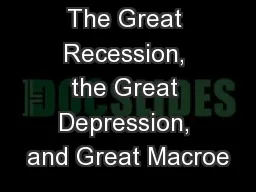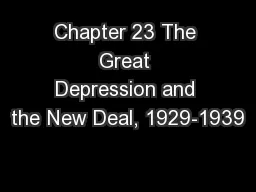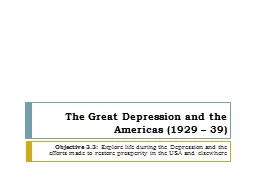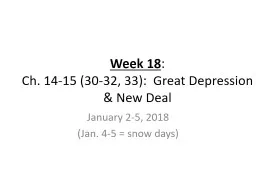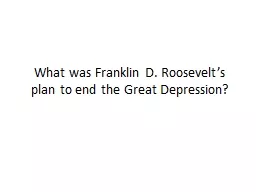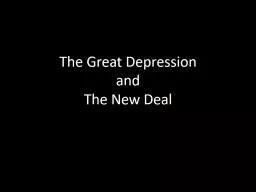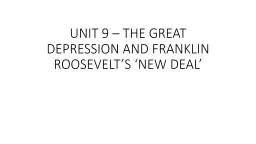PPT-The Great Depression and the New deal
Author : leusemij | Published Date : 2020-08-28
Chapter 33 19331939 Introduction Voters were in an ugly mood as the presidential campaign of 1932 neared Hoover sick at heart over the Depression was renominated
Presentation Embed Code
Download Presentation
Download Presentation The PPT/PDF document "The Great Depression and the New deal" is the property of its rightful owner. Permission is granted to download and print the materials on this website for personal, non-commercial use only, and to display it on your personal computer provided you do not modify the materials and that you retain all copyright notices contained in the materials. By downloading content from our website, you accept the terms of this agreement.
The Great Depression and the New deal: Transcript
Chapter 33 19331939 Introduction Voters were in an ugly mood as the presidential campaign of 1932 neared Hoover sick at heart over the Depression was renominated by the Republican convention in Chicago without great enthusiasm. Causes. Quick. facts. Presidents. The End. 100. 100. 100. 100. 200. 200. 200. 200. 300. 300. 300. 300. 400. 400. 400. 400. What is October 29, 1929 known as?. A. Black Tuesday. B. Black Thursday. C. Black Friday. Unit 9. Causes of the Great Depression. Guiding Questions. What economic choices caused the economy to become unstable in the late 1920s?. How did the stock market crash trigger a chain of events that led to the Depression?. 27. Previously. The AD-AS model is a simplified view of the economy that helps us evaluate short-term fluctuations in real GDP and unemployment. The AD-AS model helps us understand the macroeconomic impacts of real-world changes and gives us an important tool to use in government policy analysis. The Early Years of the Depression, 1929-1932. Down and Out: Life in the Great Depression. Worst national crisis since the _________.. First options were private charity and religious institutions. No public support. Introduction. As the presidential election neared in 1932 there were 11 million people still unemployed and their families sank ever deeper into the pit of poverty. . Hoover was renominated. , but not a lot of enthusiasm surrounded him. While a rising star of the democrats was Franklin Delano . Objective 3.3: . Explore life during the Depression and the efforts made to restore prosperity in the USA and elsewhere. Warm-Up: The Great Depression. If someone says it better, let them say . it… CRASH . 1929-1939. http://www.youtube.com/watch?v=gplaqa2yRgg. Stock market. Bull market 1920’s----Dow Jones 1924=180, 1929=381 1932=41. Buying on Margin…..5%. Banks and businesses financed brokers who facilitated risky buys. a. Discuss the Stock Market Crash of 1929, Herbert Hoover, Franklin Roosevelt, the . Dust Bowl, and soup kitchens.. b. Analyze the main features of the New Deal; include the significance of the Civilian Conservation Corps, the Works Progress Administration, and the Tennessee Valley Authority.. & New Deal. January 2-5, 2018. (Jan. 4-5 = snow days). Why are we here this week?. Students will complete Ch. 14: Great Depression (HA 30-32) collaborative, open-notes assessments, plus Ch. 15: The New Deal (HA 33).. Chapter 17 and 18. Causes of the Great Depression. Section 1. I Can Statements. Discuss the weaknesses in the economy of the 1920s.. Explain how the stock market crash contributed to the coming of the depression.. The New Deal. The government wanted to care for the citizens in need. What was the Agricultural Adjustment Administration?. New Deal program to help farmers. Federal Reserve. Supposed to protect banks, but failed during the Great Depression. The New Deal. Causes of the Great Depression. Tariffs and war debt policies. Crises in the farm sector. Availability of easy credit. Unequal distribution of income. Hoover Takes the Nation. Election of 1928. Causes of the Depression. Wall Street Crash. Stock prices =both . a symbol . &. . source of wealth during . 1920s. Stock prices increased steadily from March 1928 to . Sept . 1929. average . investor who bought $1000 in . The Great Depression hits. Hoover elected President in 1928. “predicts the end of poverty”. Warning signs of Depression. Buying stock on . Speculation. Buying on Margin. Stock prices are inflated.
Download Document
Here is the link to download the presentation.
"The Great Depression and the New deal"The content belongs to its owner. You may download and print it for personal use, without modification, and keep all copyright notices. By downloading, you agree to these terms.
Related Documents



